
For some time now, the first new range of TVs to hit the market usually comes from Panasonic, but that’s not the case in 2014, owing partly to the company’s decision to finally pull the plug on its plasma television business. This year, the mantle has been taken over by fellow Japanese TV manufacturer Sony who is extremely quick out of the blocks with its midrange Bravia LED LCD televisions. Last week, we reviewed the company’s 42-inch W7 model; now, it’s the turn of the step-up W8 series to come under our scrutiny.
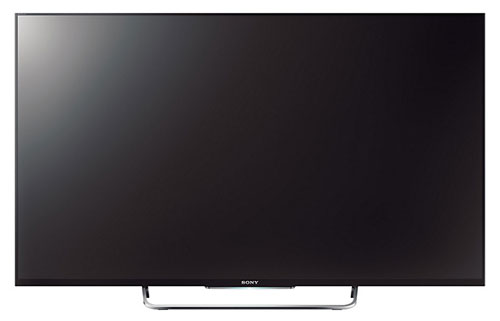
The Sony KDL50W829B is the 50-inch version within the new Bravia W8 range. Somewhat confusingly, the TV maker also had a W8 series on sale last year, but that uses an IPS LCD panel with passive 3D technology. 2014’s updated W8 features active-shutter glasses (ASG) 3D tech which suggests the presence of a VA-type panel that’s capable of deeper blacks than IPS. For the purpose of clarity, the 2014 model carries a moniker of W82-B (at least in the UK), whereas the 2013 version is also known as the W80-A.
Compared with the recently tested Bravia W705, the Sony W8 offers MotionFlow MCFI (motion-compensated frame interpolation) technology and obviously 3D capability. Are there any more differences beyond the spec sheet? Let’s find out.
Design
We thought that the Sony W7 is almost an exact carbon copy of 2013’s Bravia W6. Well, the Sony W829 IS an exact carbon copy of the W705 cosmetically. The semi-glossy LCD screen is framed by an impressively slim matte black bezel, and sits on a silver low-profile stand which cannot be swivelled but can double as a bracket for wall-mounting.
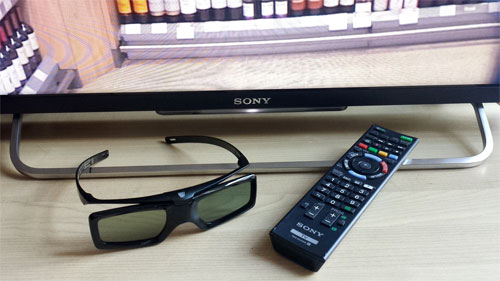
Whilst the KDL50W829 is undoubtedly a looker, what with the suitably convincing “picture suspended in thin air” effect granted by its slender bezel, some owners may be disappointed that Sony did not seek to differentiate the set from the step-down Bravia W7 series in terms of appearance, leaving any improvement under the hood. The TV comes with an external power supply which may be a plus or minus depending on your AV room arrangement. Build quality is acceptable, although the LCD panel does wobble back and forth slightly (more so than the smaller KDL42W705B) since its only secured to the stand by two screws.
Connections
Four HDMI ports are available on the Sony KDL-50W829B, of which HDMI 1 is MHL-capable, and HDMI 2 is ARC-enabled.
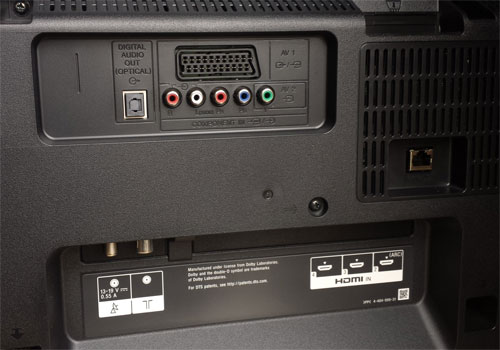 |
| Rear: 3 x HDMI, component, RGB Scart, aerial, satellite, LAN & audio out |
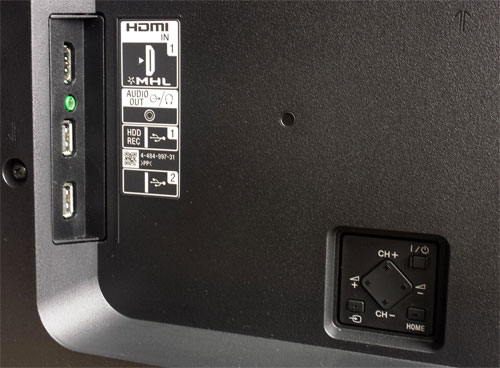 |
| Side: HDMI with MHL, 2 x USB, control buttons |
Operation
Every time our 50in W829 review unit was powered on from cold standby, it would take at least 30 seconds for certain remote button presses (for example summoning the home menu or switching input sources) to work as intended – the screen would instead return a “Please Wait” message. Once you get beyond this initialisation phase though, things do speed up.
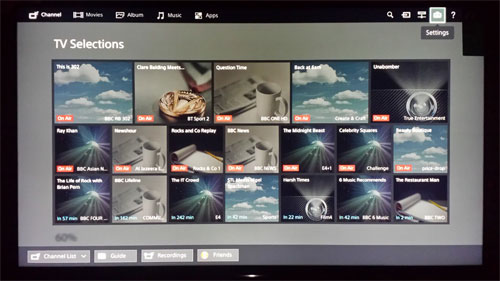
Last year’s revamped graphical user interface (which we actually quite liked) certainly didn’t last long, because Sony has commissioned another redesign of its Bravia television home menu for 2014. Fortunately the picture settings submenu remains unchanged styling-wise, though it’s been marginalised to a small, easy-to-miss icon at the top right of the home screen. Of course, the [Option] key on the remote control provides direct access to the KDL-50W829’s picture-affecting controls, allowing you to bypass the home menu altogether.
As usual, the Sony LED TV features a number of top-level picture presets lumped under the [Scene Select] menu, and if that’s not confusing enough, each [Scene Select] preset offers two further [Picture Mode] sub-presets. The two most useful [Scene Select] presets are “Cinema” for watching movies in a manner as close as possible to video industry standards, and “Game” for, uhm, playing games with minimum lag and maximum responsiveness.
Calibration
Note: Our Sony KDL50W829B review sample was calibrated using CalMAN 5, the industry-leading video calibration software.
We started off with [Scene Select] set to “Cinema” which, from our experience of testing and calibrating Sony flat-panel TVs over the years, should yield the most accurate image out of the box.
Greyscale
In [Cinema 1] mode with [Colour Temperature] left at its default setting of “Warm 2“, greys had too much green and too little blue component. The discrepancy got wider as the image became brighter.
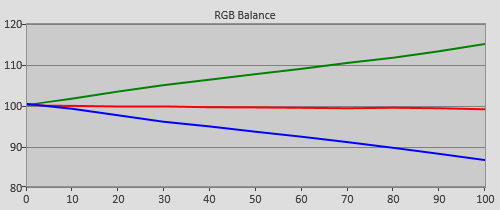 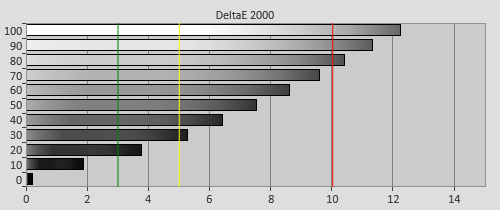 |
| Pre-calibration RGB tracking and delta errors (dEs) |
Sony’s onboard two-point [White Balance] controls came to our rescue. As with most Bravia flat-screen televisions, we only adjusted the gain controls (which in theory should have the most effect on brighter portions of the greyscale), since the bias (low-end) controls were too crude to be of use.
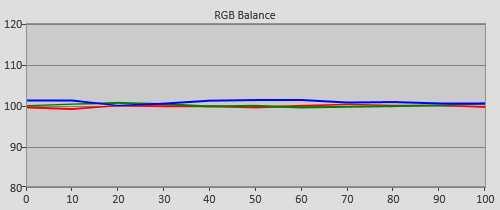 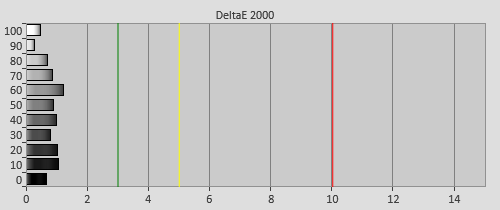 |
| Post-calibration RGB tracking and delta errors (dEs) |
The good news is, once we aligned the gain controls to D65K, everything fell into place. Delta errors dropped below 2 (the perceptible threshold for the human eye is generally accepted to be 3) across the entire luminance range, ensuring a neutral tint for high-def content displayed on screen.
Gamma
We’ve praised Sony for embracing 2.4 gamma by default in its most accurate picture mode, and we’ll keep praising them until other manufacturers do the same. 2.4 is the reference EOTF (electro-optical transfer function) for studio mastering on a flat-panel HDTV in a dark room, recommended by no less an authority than the International Telecommunications Union (ITU), so there’s really no reason to ignore 2.4 gamma in favour of the more traditional 2.2 on a capable display in a dimly-lit viewing environment.
![Pre-calibrated Gamma tracking in [Cinema 1] mode](/news/wp-content/uploads/2018/04/hdtv_Sony-KDL50W829B_pre-gamma.png) |
![Post-calibrated Gamma tracking in [Cinema 1] mode](/news/wp-content/uploads/2018/04/hdtv_Sony-KDL50W829B_post-gamma.png) |
| Pre-calibration gamma tracking (2.34) | Post-calibration gamma tracking (2.35) |
On our KDL50W829 sample, the default [Gamma] setting of “-2” in [Cinema 1] mode actually undershot 2.4 slightly, coming in at around 2.35 which is more than acceptable. Gamma tracking was largely linear, contributing to a satisfyingly rich image with realistic total transition from black to white, save for a mild brightening of shadow detail which some users actually prefer.
Colour
Our Sony 50W8 unit exhibited a shrunken colour gamut which was even smaller (albeit only marginally) than that found on the 42W7. We could expand the gamut by bumping up [Colour] or engaging [Live Colour], but unfortunately either would also throw off colour decoding, as well as introduce inaccuracies into the sub-100% saturation tracking points.
![Post-calibration colour saturation tracking in [Cinema 1] mode](/news/wp-content/uploads/2018/04/hdtv_Sony-KDL50W829B_post-strack.jpg) |
| Post-calibration colour saturation tracking |
In the end, [Live Colour] “Off” remained the most accurate setting, giving the least delta errors (dEs) when all our measured colour points were taken into account. However, the more saturated reds and blues would still look a touch muted in real-life viewing.
![Post-calibration colour errors in [Cinema 1] mode](/news/wp-content/uploads/2018/04/hdtv_Sony-KDL50W829B_post-strack-de.png) |
| Post-calibration colour errors (<3 not appreciable to the eye) |
Benchmark Test Results
| Dead pixels | None |
| Screen uniformity | Very good for an edge LED TV |
| Overscanning on HDMI | 0% if [Screen Format] “Full” & [Display Area] “Full Pixel“ |
| Blacker than black | Passed |
| Calibrated black level (black screen) | LEDs dim down to 0.011 cd/m2 |
| Calibrated black level (ANSI checkerboard) | 0.042 cd/m2 |
| Black level retention | Auto-dimming with full black screen |
| Primary chromaticity | Undersaturated red and blue primary |
| Scaling | Very good |
| Video mode deinterlacing | Decent |
| Film mode deinterlacing | Passed 3:2 cadence over 480i |
| Viewing angle | Good for VA LCD panel |
| Motion resolution | 600 to 1080 with [Motionflow] engaged; 300, off |
| Digital noise reduction | Optional; effective when engaged |
| Sharpness | Defeatable edge enhancement |
| Luma/Chroma bandwidth (2D Blu-ray) | Full luma; chroma horizontally blurred except in [Game] & [Graphics] modes |
| 1080p/24 capability | No judder in 2D or 3D with [Motionflow] “Off“ |
| Input lag (high-speed camera) | 8ms compared to lag-free CRT in [Game] mode |
| Leo Bodnar input lag tester | 22ms in [Game] mode |
| Full 4:4:4 reproduction (PC) | Yes, in [Game] and [Graphics] modes |
Power Consumption
| Default [Standard] mode | 27 watts* |
| Calibrated [Cinema 1] mode | 46 watts |
| Standby | <1 watt |
*Note: [Light Sensor] was engaged by default out of the box, which explains why energy usage was lower prior to calibration than after.
Picture Quality
Black Level
By sheer coincidence or amazing consistency, the AUO VA-type LCD panel implemented on the Sony KDL-50W829B returned the EXACT same black level as that measured on the 42in Bravia W705. Once we pegged peak white luminance to 120 cd/m2, native black level on the television came in at 0.042 cd/m2 on both a 4×4 ANSI checkerboard pattern and full-field black with auto-dimming defeated via a pause icon from our Blu-ray player. Otherwise, sending a full-screen video black signal to the W82B would cause the LED backlight to dim down automatically after a few seconds, lowering the measured black level to 0.011 cd/m2.
For readers who are not familiar with these figures, they amount to deep blacks by LED LCD standards. Contrary to what the manual states, there’s no [LED Dynamic Control] option in the user menu, so the KDL-50W829 is an edge LED TV that’s not equipped with pseudo-local dimming.
Backlight Uniformity
Our review unit exhibited fantastic backlight consistency once calibrated, without any light pooling, clouding or corner bleed in sight – a remarkable achievement on such a (relatively) large screen. Due to the way LEDs mounted along the edges are asked to illuminate the whole LCD screen, a mild dirty screen effect (DSE) was noticeable during panning shots across a uniformly toned background (think football field), but this is what we’ve come to expect from super-slim edge LED TVs, and is nothing we’d throw up our arms about.
Motion
This is one area where the Sony Bravia W82 trumps over the step-down W7 model, offering motion-compensated frame interpolation (MCFI) and black frame insertion (BFI) in various permutation and intensity through the supplied [Motionflow] control. Let’s go through the options one by one:
- “Off”: Doesn’t apply any motion-boosting technology. Motion resolution 300 as determined via the horizontally scrolling lines pattern in Chapter 31 of the FPD Benchmark Software disc.
- “True Cinema”: Ensures native 24p playback for 1080p/24 material such as Blu-ray movies. Motion resolution stays the same at 300, since there’s no MCFI/ BFI involved.
- “Standard”: Pure MCFI. Doubles motion resolution to 600. Not advised.
- “Smooth”: Pure MCFI with stronger intensity, which introduces more interpolation artefacts even though motion resolution did not increase beyond 600. Avoid.
- “Clear”: MCFI with a small component of BFI. Few interpolation artefacts with a mild decrease in on-screen luminance. Motion resolution 1080. Good for daytime general use.
- “Clear Plus”: MCFI with a higher proportion of BFI. Even less interpolation artefacts, but picture is darker than “Clear“. Motion resolution 1080. Suitable for night-time general viewing.
- “Impulse”: Pure BFI. Motion resolution 1080. May be too dim for most usage.
A quick paragraph on [Motionflow] “Impulse“, whose black frame insertion algorithm we found to be less aggressive and more user-friendly than the [LED Motion Mode] implemented on the lower-end W705 series. The KDL50W829’s [Impulse] mode evinced less flicker and double image ghosting than the KDL42W705’s [LED Motion Mode], and we managed to extract a higher light output of 49 cd/m2 with [Backlight] and [Contrast] cranked up to “Max“. Sure, it’s still quite dim, but it’s usable for viewers who crave the clearest/ sharpest motion from an LCD.
Video Processing
We discovered no new surprises with the X-Reality PRO engine on the Sony KDL50W829B which performed very similarly to other Bravia LED televisions in our array of video processing tests. Upconversion of standard-definition content was crisp with full detail capture and only very minor ringing, although [Reality Creation], if enabled, introduced the occasional flickering in busier areas on screen. Video-based material displayed with more jaggies than Panasonic, Samsung and LG HDTVs, which has always been the case for years now though we don’t find many people complaining about it.
With [Film Mode] set to “Auto“, the Sony W829B had no problem detecting and processing 3:2 cadence over 480i, but frequently lost the lock on 2:2 over 576i which is the more prevalent format for us in the United Kingdom and Europe. In other words, you may see jagged edges, line twitter or a softened image when watching film-based SD programmes through the inbuilt Freeview or satellite tuner. If you have a competent external set-top box, send a progressive signal to the TV for the best quality.
3D
The KDL-50W829 features active 3D display technology, and ships with two pairs of active-shutter 3D glasses included in the box. Unlike most active 3-D LED TVs, the W82-B doesn’t deliver full HD 3D resolution, as revealed by our own custom 3D resolution test chart:
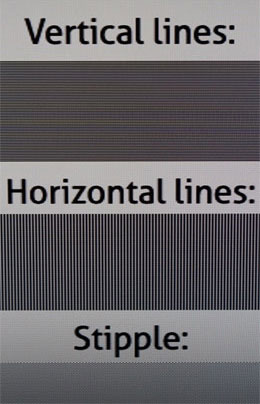 |
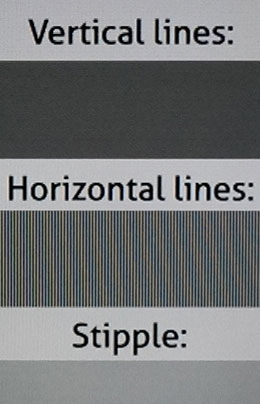 |
| Full HD 3D | Reduced vertical resolution on Sony W829 |
As you can see from the photo (cropped, unedited, unscaled) on the right which was taken from our Sony KDL-50W829B sample, the horizontal alternating black and white single-pixel lines (and even the diagonal “stipple” pattern) merge into one solid grey smudge, indicating a loss in vertical resolution. In real-world extra-dimensional viewing, this translates into a softer picture and visible jaggedness not unlike a passive 3D TV. Yet you do not even get to enjoy the lower crosstalk and flicker-free tri-dimensional images provided by passive 3D televisions. It’s just as well that Sony did not use the term “Full HD 3D” in its marketing literature, and not many people care about 3D anymore.
But if you are one of the select few who still care about the third dimension, the default [Motionflow] setting of “Standard” will cause 50Hz and 24Hz three-dimensional material to stutter on screen, since it forces the 3DTV to refresh at 60Hz. For a judder-free experience when viewing 50Hz (for example Sky 3D) or 24Hz (e.g. 3D Blu-ray) content, turn off [Motionflow].
When we sampled some high-quality 3D Blu-rays on the 50W82-B, we noticed a not insignificant amount of low-tone crosstalk and posterization which we failed to attenuate/ eradicate despite experimenting with all the options in the [3D Settings] submenu, suggesting insufficient bit depth allocation for 3-D. Put another way, the Sony KDL-50W829 is first and foremost a 2D display, with 3D slapped on as an afterthought.
Console/ PC Gaming
True to form, the Bravia W829 is a fabulous gaming display. Our Leo Bodnar input lag tester returned a figure of 22ms once the TV was switched to [Game] mode, which will surely rank among the fastest in 2014. Setting [Motionflow] to “Impulse” added a mere 8ms (half a frame), bringing the number up to 30ms. [Cinema] mode was unplayable, with an input lag measurement of 92ms.
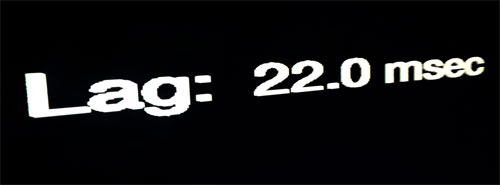
Like most Sony Bravias these days, [Game] mode on the KDL50W829 passed 4:4:4 chroma, as did [Graphics] mode, ensuring that even the tiniest colour data from relevant sources make it to screen.
Conclusion
This year’s Sony W8 is a different beast to last year’s Bravia W8, owing to a change in underlying LCD panel from IPS to VA which delivers much deeper blacks, resulting in a punchier and more alluring picture. Add accurate greyscale and 2.4 gamma to the mix, and the KDL50W829B is capable of highly filmic images, with the only slight shortcoming (as far as 2D is concerned) being undersaturated red and blue.
For many (especially gamers with an eye on input lag), the choice will be between the W829 and the step-down W705 series. On paper, the former offers 3D capability and higher motion resolution over the latter, but in reality, we found the KDL-50W829’s extra-dimensional viewing experience to be subpar because of reduced vertical resolution and inadequate bit depth. So in effect, you’re paying extra only for the motion-enhancing technologies which, to be fair, worked reasonably well on our W829B review unit. Decisions, decisions…
We would have penalised the Sony KDL-50W829B and graded it lower had the TV been priced higher, or if 3D is more than just a dying fad in most buyers’ eyes. But as things stand, it’s a 50″ HDTV, it’s good for watching movies and sports plus great for gaming, and it costs only £900 at launch. Following Panasonic’s plasma exit, we can’t imagine there being many better value-for-money proposition at this screen size for the year ahead.
Note: If you’re interested in buying this television, please support us by considering making your purchase from our advertising partner Crampton and Moore who will provide competitive prices and first-rate customer service. At the very least, please go ahead and like their Facebook page, many thanks!




First of all, thank you for the, as always, great review.
I’m considering this TV right now after reading very positive feedback on avforums about the 50W829 having really great uniformity with next to no DSE. I’ve already tried my luck with a 42W705B and it was really awful. Four thick, dark, vertical bands with perfectly symmetrical spacing of around 20 cm and lots of clouding.
Would you say the 50W829 is worth the premium compared to the 42W705 considering it has configurable Motionflow and a bigger screen? I don’t really care about 3D, as I don’t like it and the TV will be used mainly for gaming, but the Motionflow would be nice to have for movies or sports. I’m sitting about 1.8 meters away from the TV, would 50 inches still be suitable or should I try another 42W705 or even 42W655?
Thanks in advance and keep the reviews coming :)
Thans for your review. Going to buy a new TV this week and was very interested in this model. But the W905A will still be the TV of my choice.
@Alwin: If I were you, I’d at least wait until the W955 review hits, although I expect it to not score as high as the W905. My hope is that after the W705 and the W829 this will be next one on the review list.
@Yoppa I know that TV is coming. But that TV is too big for me. 46inch is perfect. 50inch was already on the big side. And I need a TV this week or else I will be sitting in my apartment without TV. It couild be weeks before the W955 becomes available.
@Ben: Thanks for your kind words. It was only after publishing this review that I looked up the prices for the same size between the W705 and W829, and I’m surprised by how little the difference is (around £50 to £100 more). So I’d say yes, the W829 is worth paying more for the motion clarity.
1.8m is probably too near for watching SD on a 50″ screen, but is ideal for decent HD content. Depends on what you value more.
@Alwin: Calibrated a Sony W905 for a long-time reader over the weekend. What a superb set… I really doubt the newer W955 can beat it.
@Yappa: ;-)
Warmest regards
Vincent
Hey, interesting review, thank you! I guess it means asking a bit much, since you already did two Sony in row, but will you consider reviewing the 42″ version of the W8? I guess it will be quite a different beast again, considering the passive 3D and 1/2 motionflow rate when compared to the 50″/55″. I am right now torn between the W7 and the W8, the latter offering additional motion clarity (and 3D as a bonus). More than 42″ isn’t an option for me right now and I would love to compare reviews with the 42″ W7 you a already did.
@Vincent Teoh: Winking smiley detected! :D
Looking forward to read what you have to say about the W955.
I had the W905, but couldn’t live with the off axis viewing pink shift that you also mentioned in your review. The W955 seems to better in that regard, but might be no match when it comes to blacks.
@Vincent Teoh: I only really use the TV for gaming, so it’s at least 720p, and don’t watch much SD material. If I do, I don’t expect it to look good anyway, so I guess it’s fine and I will probably give the 50W8 a shot. If it looks too big at first, I just have to get used to it :D
@Ben: No one has ever complained about having too big a TV after two weeks. Fact. :-)
Warmest regards
Vincent
Hi, thanks for this and other reviews. I’m a gamer and it’s great that in your reviews you test input lag and 4:4:4 support. There is one major thing that i miss in your reviews and that’s pixel response time, which is also a very important parameter for any gamer. I had a few Samsung TVs with VA panels in the past and they were all very disappointing for slow pixel response time, especially when displaying content with lots of dark color tones. There was a lot of trailing/ghosting/smudging in dark scenes. I wonder how the W829 and W705B are in this regard, do they have some sort of overdrive functionality (like gaming monitors) to improve pixel response time for gamers? Thanks in advance.
@Vincent Teoh: Haha, you’re probably right. The bigger the better right? Dat immersion. ;)
@Kestas: Those TVs probably utilize some sort of overdrive but it’s not configurable like on some pc monitors. Generally and from my own experience, with both AUO and Samsung panels, AUO panels have almost no visible black trailing or smearing. There’s always a bit, but that’s unavoidable really. For VA panels, the motion looks very clean, even in dark scenes.
I picked up a 46W905 last week from the Sony Outlet UK store and although the picture on HD content was superb, best I have seen, it was let down by lots of DSE and vertical banding on my set, most noticeable when watching football. Now this may have been why it was sent back to Sony in the first place, I don’t know. They don’t have any more they can send me so I am having a refund.
I am now looking at this 50″ instead and have only seen glowing reviews so far. My only concern is the DSE and banding when watching football. You note there was some in your review but how bad was it. I watch a lot of football and with the World Cup in the summer, even more no doubt so want to ensure I get the best set with no DSE or banding (does it exist?). Not too fussed on 3D as it’s a gimmick and can’t get on with Active anyway. Also is the screen as reflective as the W905 as in sunlight it was quite off-putting.
Hi, Can You guys provide callibration settings for this model? Something that i can start with?
Thank you for the excellent review.
I’m actually considering purchasing this model as soon as it is released here (in the Netherlands). I just have one question before I’m making any definite decisions. I currently own an older Sony KDL32D3000 model (which was also reviewed by your website a number of years ago). Will the viewing angle of the W829B be less than what I’m used to with this older (D3000) model? Or will it be about the same? If it’s less, will this be very noticable in everydag viewing? I’m asking this because sometimes in the evening I tend to lie down on the couch to watch some tv. I don’t want the image to become ‘darker’ when I do that. I thank you in advance for answering my question.
Sincerely,
Mark
@Mark Schipper: Lying down on the couch and looking up at the TV? The image wouldn’t become “darker” with a VA panel like this, it would become brighter. The same happen when you look at the TV from above or either side.
I am still confused between SONY KDL 55W905A, SAMSUNG UE55F7080 and this one (SONY KDL 50W829), although I will have to wait for the later as it is not available here yet. Anyways, it would be great if you could make a recommendation!! Thanks.
I’m thinking of picking this set up, but having seen my girlfriend’s rather high end Samsung in game mode look completely washed out and rather disastrous, how does the W829 fair in this department?
Thanks for your time!
Hi vincent how would you rate this against panasonics e6?
I went from the kdl47w805a to the kdl50w829b… would I notice a difference in color in game mode between the two? Would my newer TV be better or at least the same? Also would I notice much of a difference from 17ms input lag to 22ms input lag with the w829b?
Thank you!
Hello,
I’m a big fan of the website, but I’ve always wanted to ask why you rarely post the post calibration settings of your reviewed TVs?
Many thanks,
Karim
@Karim: Please see here for the reason: http://forums.hdtvtest.co.uk/index.php?topic=7202.0
Warmest regards
Vincent
Can we get some optimum settings posted for this? Thinking of picking one up today
Hello guys and thanks for the work you do. It really make things easier when some shops only display pre choosen materials to make some specific tvs to pop and to make others look disapointing.
Now i do have 3 questions that i would like a reply from you guus or any of the other readers.
How do you think this tv performs against a H6400 from samsung?
Whats the diference between the W829 and W 828?
Does this tv have any sort of dual monitor using the active glasses? With passive it would had been easier but now… And if so does this reduction in vertical resolution using the glasses maintain gaming?
Thanks alot!
Sérgio Amorim
Hi i have question about the difference between 42 inch and 50 inch.Are they same in specs?
@Angelsx: 42W829 is passive 3D, 50W829 is active 3D.
Warmest regards
Vincent
Thank you for replay mr Vincent.I know that for the 3d.I just wanna know is there motion flow on 42inch model and what about input lag?Is it same like 50inch model?Thank you again and regards :)
@Vincent
Thank you Vincent for the awesome review! I have a quick question regarding HDTV’s that can/cannot support 4:4:4 Chroma and next-gen console gaming (specifically the PS4/Xbox One). Now that the next-gen consoles that are out are built more similarly to a PC, would I need a HDTV that can support 4:4:4 chroma to get the optimal PS4/Xbox One image? Is the difference in picture quality of next-gen console gaming on a 4:4:4 HDTV and a non-4:4:4 HDTV that noticeable? Thank you for the help, it’s much appreciated!
Hello, is it possible to subscribe to this thread/comments ? Or have I just done it by posting here lol?
Like other Im interested too in the Input Lag stats on these new Sonys, I made the dumbass mistake of buying a sony 32″ thinking only the size was different, but Ive seen on here the input lag is massively different to the 40″ of the same model :(. Im never going to be able to afford the 50″ TVs but Im would like a W8 40″, just dont want to end up with the same issues, its quite stunning that Sony dont boast about input lags the way Monitor makers do.
Thanks for all your work :)
1. Does Sony W829 has better or the same quality of motion picture compared to Sony HX753?
2. I’m considering what to buy – Panasonic Plasma VT60 or this LED Sony W829. Most important thing for me is comfort of watching in dark environment – good black level of screen. I know that plasma is better when we compare screen with 120 cd. In dark room I don’t need 120 cd – I suppose that it is to much to not waste eyes.
In this situation on LED TV we can decrease the power of backlight to improve blacks, on plasma not.
Now I have Samsung D8000 (Led) and Panasonic ST50 (plasma). I’m not shure that plasma is better (baclight in Samsung set to 2) and from time to time I have a pain of my eyes with plasma but not with LED.
Do You have any opinion what will be beter – LED Sony W829 or plasma VT60?
ps.
Your tests are fantastic.
Miltoniusz
@Miltoniusz: VT60 is better.
Warmest regards
Vincent
Thank You. You are right. I have tested my ST50 again and in fact black level is as good as I need – almost ideal. But … when I set contrast to zero, in spite of this, in dark room screen is to bright for me. Much to bright. On LED I can achive lover, more comfortable level. Does VT60 can achive lower level of brightnes then ST50? Much lower? Perheps Sony W829 is beter choice – especialy in Impulse mode? I just ordered VT60 in shop and now I am wondering what to do – stop order or not. Please, help.
Warmest regards
Has anyone tried the 55″ model? Does it have the same quality as the 50″?
Hi Vincent, I’m about to pull the trigger on a 55 W8. However, it is a 55W800B and not the reviewed W829B. Are there any major differences I should be aware of?
THERE IS NO MOTION FLOW SETTINGS ON THE KDL42W829 WHY DID U NOT POINT THIS OUT TRUST ME I HAVE IT HERE,SAYS ON SONY WEBSITE 400HZ HAVE WE BEEN LIED TO AGAIN I ALREADY SWAPPED OVER THE W6 FOR THIS
I wanted to go for the 42w805b model but read that it uses a lower quality (IPS) screen from LG, and not the AUO panel (http://www.s21.com/sony-kdl-42w829.htm), is that true?
Hi vincent. I observe that are 3 models w805, 815 and 829. The difference that I observe is motion flow. 400 600 800. Are other difference? This motion are,so,visible? Are difference in color in image in other department? Thank you
can you post your settings for the calibrated screen. i was wondering how they compare to the calibrated screen they produced over on AV Forums.
https://www.avforums.com/threads/sony-w829-kdl-50w829-reviewers-recommended-best-settings.1869036/
thank you
Hi Vinc
How would you rate this TV agains the Panasonic AS640?
Main use for me is HD-TV- Sports\HD Videos watching Generally, not a gamer.
Thanks
Max
Oh and I forgot to mention, not interested in 3D neither.
The article says, “once we aligned the gain controls to D65K, everything fell into place.” Does anyone know what these three gains should be set to in order to achieve this?
Just bought this tv, colours bother me in some games for example -destiny. I don’t have any calibration software or anything hence I cannot configure my tv properly.. I set it on game mode ofcourse and turnes all post proccessing off… But for example in xbox i cannot configure rbg at all.. I have colour set at 60, and live color off, I’d like to try your setup with the low deltaerrors.. Do you remember at all what was your configurations in “white balance” option R gains b gain, r bias…etc? I’d like to try your setup if it works for me aswell..
And is the 4:4:4 automaticly on in my game made or should i change something to acquire it? I got dynamic range set as limited if that is relevant at all.. I can change it to full but and change on my xbox aswell to full but i cannot calibrate the birghtness properly, it destroys my blacks
@Tom Edwards
“The article says, “once we aligned the gain controls to D65K, everything fell into place.” Does anyone know what these three gains should be set to in order to achieve this?”
This is my question too. Why go to the length of describing all this stuff, if we don’t know how to achieve it?
I would like to request the calibration settings too. It would be very helpful.